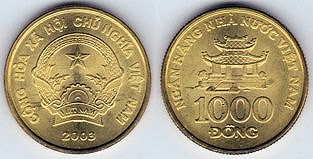
CHAPPIDI ABHIRATH REDDY,
C/O COL GKS REDDY,
The rupiah (Rp) is the official currency of Indonesia. Issued and controlled by the Bank of Indonesia, the ISO 4217 currency code for the Indonesian rupiah is IDR. Informally, Indonesians also use the word "perak" ('silver' in Indonesian) in referring to rupiah. The rupiah is subdivided into 100 sen, although inflation has rendered all coins and banknotes denominated in sen obsolete.
The Riau islands and the Indonesian half of New Guinea (Irian Barat) had their own variants of the rupiah in the past, but these were subsumed into the national rupiah in 1964 and 1971 respectively (see Riau rupiah and West New Guinea rupiah).
There are presently two series of coins in circulation: aluminium, bronze and bi-metallic coins from 1991–1998 and light-weight aluminium coins from 1999 onwards. Due to the low value and general shortage of small denomination coins (below 100 rupiah), it is common to have amounts rounded up (or down) or to receive sweets in lieu of the last few rupiah of change in supermarkets and stores
My collection of Indonesian Coins is very meagre. In spite of my best efforts, I could not procure low denomination coins.
One Rupiah - Fan Tail Flycatcher - 1970 - Steel Coated Aluminium
Five Rupiah - Family Planning Programme - 1974 - Steel Coated Aluminium
Ten Rupiah - FAO - 1974 - Nickel
One Hundred Rupiah - 1978 - Nickel
Five Hundred Rupiah - 1991 - Aluminium Bronze
One Thousand Rupiah - Palm Tree - 1996 - Bi Metallic
Malaysia Coins
The Malaysian ringgit (plural: ringgit; currency code MYR; formerly the Malaysian dollar) is the currency of Malaysia. It is divided into 100 sen(cents). The ringgit is issued by the Bank Negara Malaysia.
The first series of sen coins were introduced in 1967 in denominations of 1 sen, 5 sen, 10 sen, 20 sen, 50 sen, followed by the introduction of the 1 ringgit coin (which used the $ symbol and is the largest coin in the series) in 1971. While varied by diameters, virtually all the coins were minted in near-consistent obverse and reverse designs, with the obverse depicting the then recently completed Malaysian Houses of Parliament and the federal star and crescent moon derived from the canton of the Malaysian flag. All coins were minted from cupronickel, the only exception being the 1 sen coin, which was first composed from bronze between 1967 to 1972, followed by steel clad with copper from 1973 onwards. The 50 sen coin is the only coin in the series to undergo a redesign—a minor modification on its edge in 1971 to include "Bank Negara Malaysia" letterings. All coins has an initial GC on the coin reverse, below the Parliament House, stand for Geoffrey Colley, Malaysia 1st series coin designer.[verification needed]
Minting of the first sen series was halted in 1989 when the second series was introduced in circulation. The coins, however, remain in legal tender as of 2013, but have steadily declined in numbers since the 1990s and are now scarcely in circulation. The $1 coin has not been in common circulation since the introduction of the second series $1 coins.
My Collection of Malaysian Coins, though meagre, is just the opposite of Indonesia, as I have only small denomination Coins.
One Sen - 1987 - Copper Coated Steel
One Sen - 1999 - Copper Coated Steel
Five Sen - 1976 - Cupro Nickel
Ten Sen - 1982 - Cupro Nickel
Ten Sen - 1999 - Steel Coated Aluminium
Twenty Sen - 1988 - Cupro Nickel
Twenty Sen - 1997 - Steel Coated Aluminium
Fifty Sen - 1998 - Steel Coated Aluminium
Vietnam Coins
The đồng (/ˈdɒŋ/; Vietnamese: [ɗôŋm]) (sign: ₫; code: VND) has been the currency of Vietnam since May 3, 1978. Issued by the State Bank of Vietnam, it is represented by the symbol "₫". Formerly, it was subdivided into 10 hào, which was further subdivided into 10 xu, neither of which is now used.
First đồng
In 1978, aluminium coins (dated 1976), were introduced in denominations of 1, 2, and 5 hào and 1 đồng. The coins were minted by the Berlin mint in the German Democratic Republic. Due tochronic inflation, no coins circulated for many years.
Second đồng
Commemorative Issues: Commemorative coins in copper, brass, copper-nickel, silver, and gold have been emitted since 1986, but none has ever been in circulation.
2003 Issue
The State Bank of Vietnam resumed issuing coins on December 17, 2003. The new coins, minted by the Mint of Finland, were in denominations of 200, 500, 1,000, 2,000, and 5,000 đồng. Earlier, Vietnamese had to exchange banknotes for tokens with a clerk before purchasing goods from vending machines. Many residents expressed excitement at seeing coins reappear after many years, as well as concern for the usefulness of the 200 đồng coins.
Two Hundred Dong - 2003 - Steel Coated Aluminium
Five Hundred Dong - 2003 - Steel Coated Aluminium
One Thousand Dong - 2003 - Brass Coated Aluminium
Two Thousand Dong - 2003 - Brass Coated Aluminium
Five Thousand Dong - 2003 - Bronze
Note - Some of the images of coins in my collection, have been taken from the Gallery to the extent available, to save on time & effort involved in photography & editing



















No comments:
Post a Comment